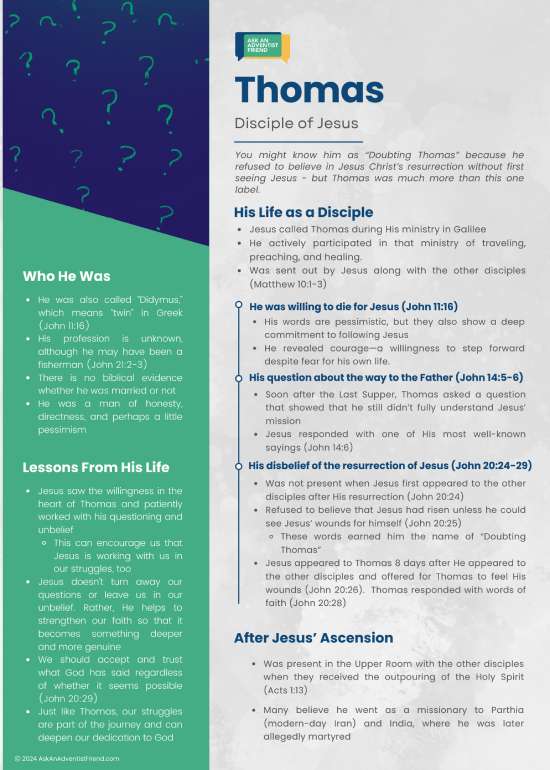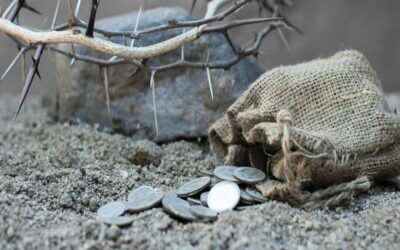 You might know him as “Doubting Thomas” because he refused to believe in Jesus Christ’s resurrection without first seeing Jesus.
You might know him as “Doubting Thomas” because he refused to believe in Jesus Christ’s resurrection without first seeing Jesus.
But Thomas was much more than this one label.
As one of the 12 disciples of Jesus, Thomas the Apostle followed Jesus and grew in His work of teaching, preaching, and healing. Despite his struggle with unbelief after Jesus was resurrected—the story that made Thomas famous—he went on to spread the Gospel throughout the known world.
The Bible doesn’t spend a lot of time talking about this unique character, but we’ll look at what it does say and what scholars have concluded from clues in history. You’ll learn:
Who Thomas was

Photo by Kevin Malik
In the New Testament, Thomas shows up in every single list of the 12 disciples (Matthew 10:3; Mark 3:18; Luke 6:15). But we know little else about him except for the accounts of him in the Gospel of John. These snippets of his interactions with Jesus and the other apostles show us a man of honesty, directness, and perhaps a little pessimism.
John 11:16 tells us that he was also called “Didymus,” which means “twin” in Greek (and the Aramaic for Thomas means the same). It’s possible that he had a twin brother, though we don’t know who that was.
Some suggest he was Jesus’ twin, but the Bible doesn’t offer any such evidence.1
And while some movies or TV shows depict him as having a wife or girlfriend, the Scriptures don’t say whether he was married or not.
His profession also is unknown. However, John 21:2-3 mentions that he went fishing with some of the apostles, so it’s possible he was also a fisherman.
Thomas’ life as a disciple
Like the other disciples, Jesus called Thomas during His ministry in Galilee. Thomas actively participated in that ministry of traveling, preaching, and healing.
After Jesus had mentored His disciples for some time, He even sent them out on their own, as Matthew 10:1 tells us:
“When [Jesus] had called His twelve disciples to Him, He gave them power over unclean spirits, to cast them out, and to heal all kinds of sickness and all kinds of disease” (NKJV).
Thomas was among those who were sent out (Matthew 10:3).
Little is said about what happened to Thomas during those mission trips, but the Gospel of John does record three interactions Thomas had with Jesus. More on those next.
His willingness to die for Jesus (John 11:16)
The first recorded interaction happened when Jesus received word of His friend Lazarus’s sickness. Lazarus was a close friend of His, and no doubt, the message from Lazarus’s sisters, Mary and Martha, came with the expectation that Jesus would come and heal him.
But that meant going back to Judea. The disciples protested:
“Rabbi, lately the Jews sought to stone You, and are You going there again?” (John 11:8, NKJV)
Why would Jesus go near Jerusalem, where religious leaders were plotting His death?
Jesus, though, recognized the importance of going to Lazarus (who had since died) and resurrecting him (John 11:14-15). This was part of His mission.
And that’s when Thomas pipes up:
“Let us also go, that we may die with Him” (John 11:16, NKJV).
His words are pessimistic, but they also show a deep commitment to following Jesus. Here’s how Adventist scholars put it:
“Since [Thomas’s] Master was bent on going to Bethany, his loyalty led him to follow, though to him, with his mind full of the darkest apprehension, it appeared that they were walking into the jaws of death.”2
He revealed courage—a willingness to step forward despite fear for his own life.
His question about the way to the Father (John 14:5-6)

Photo by Kaushik Panchal on Unsplash
The second interaction the Bible records happens soon after the Lord’s Supper. Jesus is with His disciples, seeking to comfort them before the crisis of His arrest and crucifixion.
Jesus gives them this beautiful promise:
“Let not your heart be troubled; you believe in God, believe also in Me. In My Father’s house are many mansions; if it were not so, I would have told you. I go to prepare a place for you. And if I go and prepare a place for you, I will come again and receive you to Myself; that where I am, there you may be also. And where I go you know, and the way you know” (John 14:1-4, NKJV).
And yet, Thomas is perplexed and asks:
“Lord, we do not know where You are going, and how can we know the way?” (John 14:5, NKJV)
His question showed that he still didn’t fully understand Jesus’ mission. Like many of the Jews, he incorrectly expected the Messiah to conquer the Romans and set up an earthly kingdom—the apostle Peter, too, had wrestled with this misconception (Matthew 16:22).
The Seventh-day Adventist Bible Commentary points out that the disciples “should have known [the answer to Thomas’s question], for they had been clearly told (see verse 4). It was hard for them to divest themselves of the tempting Jewish concept of the Messianic kingdom.”3
We can be thankful that Thomas asked the question, though.
It prompted one of the most well-known sayings of Jesus:
“Jesus said to him, ‘I am the way, the truth, and the life. No one comes to the Father except through Me’” (John 14:6, NKJV).
Thomas and his fellow apostles took a while to understand what this really meant, and their misconceptions would cause deep disappointment—so much so that Thomas would, in fact, not even believe the resurrection at first.
Let’s see how Jesus responded to him.
His disbelief of the resurrection of Jesus (John 20:24-29)

Photo by Lexi Laginess on Unsplash
The disappointment was over. Jesus had risen and appeared to all the disciples for the first time in the upper room!
All of them except Thomas (John 20:24).
He was not present at the time, whether out of discouragement or fear or some other reason. When he heard from the other disciples that they had seen Jesus, perhaps he felt a little spiteful that he’d been left out. We don’t know for sure.
His response, though, was adamant:
“Unless I see in His hands the print of the nails, and put my finger into the print of the nails, and put my hand into His side, I will not believe” (John 20:25, NKJV).
These strong words have earned him the name “Doubting Thomas,” though perhaps “Unbelieving Thomas” is more accurate. After all the disappointments of the past couple days, his sentiments are relatable. It was probably hard to muster faith in that moment.
It was nothing Jesus had said or done that caused Thomas’ doubt. From everything we know about Thomas, he had trusted in Jesus up until now. But he was still struggling to understand Jesus’ true purpose as the Messiah.
Jesus understood, though. Eight days later, He appeared to the disciples again—this time with Thomas present.
He approached Thomas directly:
“Reach your finger here, and look at My hands; and reach your hand here, and put it into My side. Do not be unbelieving, but believing” (John 20:27, NKJV).
Jesus made it clear that He knew the thoughts this apostle was struggling with, and that was enough for Thomas:
“There is no evidence that Thomas took advantage of the offer. The fact that the Lord read the doubts of his heart so accurately was to him convincing evidence of the resurrection.”4
Thomas’s next words were ones of faith:
“My Lord and my God!” (John 20:28)
In this verse, “my Lord” is a translation of the Hebrew “Yahweh,” which means that Thomas recognized Jesus as the same Jehovah God spoken of in the Old Testament.5
This faith would carry him forward in his mission as an apostle.
Thomas after the ascension
Thomas was present in the upper room when the 12 apostles—including Peter, James, John, Andrew, Judas (Thaddeus), and Philip—and other followers of Jesus prayed together and received the outpouring of the Holy Spirit (Acts 1:13). After that, the biblical account doesn’t say anything more about him. However, many believe he went as a missionary to Parthia (modern-day Iran) and India,6 where he was later martyred.
Christians in the state of Kerala in India believe that Thomas came there and first brought Christianity in AD 52.7
Adventist scholars mention something similar:
“In southern India there is a group of indigenous Christians who have been known for centuries as Thomas Christians. They have in their possession a version of the gospel story said to have been handed down to them by the apostle Thomas. They claim that Thomas suffered martyrdom on an eminence known as St. Thomas’ Mount, near Madras.”8
Church traditions also suggest that, during his later ministry, Thomas wrote books like the Gospel of Thomas and the Infancy Gospel of Thomas, though biblical scholars have many reasons to reject that he was the author.
For example, the Gospel of Thomas, which is supposedly a collection of 114 of Jesus’ sayings, is thought to have been written in the middle of the 2nd century—long after Thomas was alive. It also reflects the thinking of Greek mystics (Gnostics) because it connects salvation to knowing these secret sayings of Jesus.9 It isn’t consistent with the Bible.
As for Thomas’s death, we again don’t know for sure what happened, though it’s likely that he was martyred for his faith, as many of the other apostles were. Foxe’s Book of Martyrs gives this account:
“After converting many to Christ, he aroused the anger of the pagan priests, and was martyred being thrust through with a spear.”10
No longer unbelieving, Thomas chose to give his life completely for his risen Lord.
What Thomas’s life teaches us

Photo by Olivia Snow on Unsplash
Thomas, along with the other disciples, had a challenging call upon his life. To be a disciple of Jesus went against his preconceived ideas about the Messiah and brought him great disappointment. But Jesus saw the willingness in the heart of Thomas and patiently worked with his questioning and unbelief.
It encourages us that Jesus is working with us in our struggles, too.
Though we may struggle to believe or understand all Jesus has in store for us, He doesn’t turn away our questions or leave us in our unbelief. Rather, He helps strengthen our faith so that it becomes something deeper and more genuine.
God often reaches us through personal encounters, just as He did with Thomas after the resurrection. Thomas needed to know at that moment that Jesus knew his thoughts of unbelief, and the experience transformed him.
Though God may not appear to us visibly, this story encourages us to accept and trust what God has said regardless of whether it seems possible. And from the story of Thomas, we find a special blessing for us:
“Jesus said to him, ‘Thomas, because you have seen Me, you have believed. Blessed are those who have not seen and yet have believed’” (John 20:29, NKJV).
Those small seeds of belief will grow in our lives, just as they did in Thomas’s. Though you may feel like you’re struggling, take heart. Those struggles are part of the journey, and they will deepen your dedication to God. Just as they did with Thomas.
Related pages
- Nichols, Francis, ed., The Seventh-day Adventist Bible Commentary, vol. 5, p. 1013. [↵]
- Ibid. [↵]
- Ibid., p. 1035. [↵]
- Ibid., p. 1068. [↵]
- Ibid. [↵]
- Coogan, Michael, The Oxford Companion to the Bible, p. 743. [↵]
- Zacharia, Paul, “The Surprisingly Early History of Christianity in India,” Smithsonian Magazine. [↵]
- The Seventh-day Adventist Bible Commentary, vol. 5, p. 596. [↵]
- Wallace, J. Warner, “Why Shouldn’t We Trust the Non-Canonical Gospels Attributed to Thomas?” Cold-Case Christianity. [↵]
- Foxe, John, Foxe’s Book of Martyrs, p. 34. [↵]
More Answers
Who is Mary Magdalene in the Bible?
Mary Magdalene was a remarkably dedicated follower and supporter of Jesus Christ during His earthly ministry.
Getting to Know Mark—Gospel Writer and Follower of Jesus
Mark (whose full name was John Mark) had a lot of roles in the New Testament: he was an early follower of Jesus Christ, he traveled the Mediterranean as a Christian missionary, and he wrote a book of the Bible.
Understanding Luke: The Beloved Physician, Historian, and Evangelist
Who was Luke in the Bible? What was he known for and what contributions did he make for the early church? Find out here.
Exploring the Life of the Apostle Paul
The apostle Paul went from Pharisee to Christian after a miraculous encounter with Jesus. He spent the rest of his life spreading the Gospel and writing words we still read today.
All About the Disciple, Simon the Zealot
“Simon the Zealot” was one of the 12 disciples chosen by Jesus Christ. But despite this important role, the New Testament doesn’t provide specific details about his life, family, job, etc.
Judas Iscariot, the Most Infamous Disciple of Jesus
Judas Iscariot is best known for betraying Jesus with 30 pieces of silver. This page looks more closely at who he was and what led him to do so.
Who Is Thaddeus, the Disciple?
Thaddeus (or Thaddaeus) is one of the more unique and obscure figures among Jesus Christ’s disciples in the New Testament. Though we know little about him from the Bible or tradition, we do know that he went by a few names, specifically Thaddeus, Lebbaeus, and Judas of James.
Matthew—From Tax Collector to Jesus’ Disciple
In the first book of the New Testament, we find the Gospel story from the perspective of Matthew. He was a Jewish tax collector from Capernaum in the first century AD, and he was likely despised by fellow Jews for choosing that profession.
Who Was Jesus’ Disciple Named James, Son of Alphaeus?
Two of Jesus’ 12 disciples were named James. While more is known about James the son of Zebedee and brother of John, let’s see what there is to know about the other James, known as James the son of Alphaeus—also sometimes referred to as “James the Lesser.”
All About the Disciple James, Son of Zebedee
James the son of Zebedee was a fisherman who became Jesus’ disciple. Discover how his decision to follow Jesus shaped his life and the beginnings of the early Church.
Who was the Apostle John?
What does the Bible say about the apostle John? What is he known for today? Learn more about John’s life, ministry, and legacy here.
All About Bartholomew, a Disciple of Jesus
Even before Bartholomew met Jesus, he was eagerly awaiting the arrival of the Messiah. Discover how he came to follow Jesus and what his discipleship means for us today.
What Do We Know About Andrew the Disciple?
Andrew was Jesus Christ’s first disciple (John 1:37-40) and the first to recognize Him as the Messiah.
Simon Peter: Fisherman to Disciple to Apostle
Simon Peter was a simple fisherman who became one of the most well-known disciples of Jesus Christ. He is perhaps best known for being part of Jesus’ inner circle of three disciples, walking on water, and proclaiming Jesus as the Son of God.
Who Was Philip the Disciple In the Bible?
Philip was one of the 12 disciples called by Jesus Christ during His earthly ministry. He was originally from the city of Bethsaida and to this day is often known as the “practical disciple.”
King David: How Was He a Man After God’s Own Heart?
War, bloodshed, murder, adultery—all of these crimes overshadowed the life of a biblical Old Testament man named David. Yet he was called a man after God’s own heart, not to mention one of Israel’s greatest heroes and kings.
The Story of Moses in the Bible: What His Life Teaches Us
A baby on death row, an outcast prince, a humble shepherd, and an unlikely deliverer. All these titles describe the individual that led Israel out of slavery in Egypt to the borders of the Promised Land.
The 42 Kings (and 1 Queen) of Israel and Judah in the Bible
Conspiracies, royal scandals, dictatorships—history is full of them. And Bible history is no different when we stop to look at the kings of ancient Israel in the Old Testament.
Who Were the Israelites in the Bible?
The Israelites in the Bible, also known as the children of Israel or ancient Israel, were a nation God called to represent Him to the world. As recorded in the book of Exodus, He delivered them from slavery in Egypt under Moses’s leadership and brought them to the Promised Land of Canaan (located in a similar area to present-day Israel).
What We Can Learn from the Life of Joshua
Joshua was an iconic leader in the Old Testament of the Bible. As a successor to Moses, he was both a humble servant of God and a strong warrior. God called Him to lead the nation of Israel to take possession of Canaan, the Promised Land—a task he took on with faith and courage.
Why is Abraham Important in the Bible?
God communicated directly with Abraham and made a covenant with him that would provide land, protection, and fruitfulness for his descendants. And he indeed became the father of many nations, making him a foundational figure in three monotheistic world religions: Judaism, Islam, and Christianity (Genesis 17:5, 19-20; Genesis 25:1-6, 12-18).
Who Were the Judges of Israel in the Old Testament?
Times of crisis call for men and women of action. The Israelites, newly settled in the Promised Land, found themselves in those times. As enemy nations attacked and oppressed the tribes, they cried out to God for help. He, in turn, sent them men and women of action—known as judges.
Life Lessons from Joseph in the Bible
Joseph is one of the more well-known people from the Bible’s Old Testament. He showed remarkable strength, faith, and patience—even while facing great difficulty and injustice. All because he let God lead.
Didn’t find your answer? Ask us!
We understand your concern of having questions but not knowing who to ask—we’ve felt it ourselves. When you’re ready to learn more about Adventists, send us a question! We know a thing or two about Adventists.


























